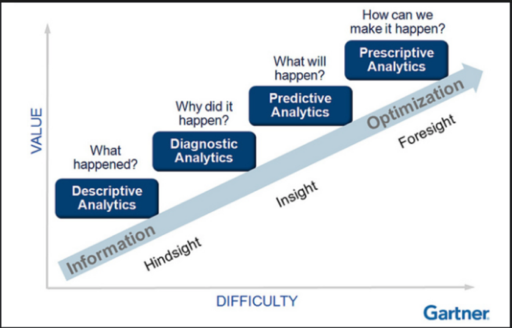A value proposition to improve patient care in clinical lab
December 14, 2019 | Saturday | Views | By Dr. Sujay Prasad
Data science is the buzzword everywhere today and its sphere of influence reaches a large area from business, health care, service sector, governance, industry, to advanced research.
Figure 1 Gartner's Business Analytics Maturity Model
Over time, introduction of AI in healthcare has stimulated an active discussion of whether AI doctors will eventually replace human physicians in the future. Though there is a prevailing belief that human physicians will not be replaced by machines in the foreseeable future, AI can definitely assist physicians to make better clinical decisions or even replace human judgement in certain functional areas of healthcare (E.g. radiology). Healthcare’s data-heavy nature makes it perfect for the application of AI across multiple disciplines, from diagnosis and pathology to drug discovery and epidemiology.
Data science is the buzzword everywhere today and its sphere of influence reaches a large area from business, health care, service sector, governance, industry, to advanced research. Data science is the conglomeration of statistical analysis, data mining, business intelligence, machine learning and data analytics. It involves developing methods for recording, storing, processing and analysing data to gain insights and knowledge from any type of data, be it structured data like tables and excel sheets or unstructured data like texts, images, videos, machine data, log data from websites, servers, networks and applications, data from mobiles, and IOT connected devices.
Technology and information science have revolutionised healthcare sector too, especially laboratory services. With the present trend of digital pathology and digitisation of information, medical laboratories are generating large amount of data ranging from digitised reports to demographic details, quality control, test results, method evaluations, and proficiency testing. In addition to clinical laboratories, data is also generated by government health agencies, public and private health agencies, Self-tracking devices which monitor sleep, diet, activity, stress etc., hospitals and other health care sectors. When all these data are integrated, we have the massive data called ‘BIG DATA’ which can advance healthcare analytics to a higher level.
Gartner’s Business Analytics Maturity model in Fig.1 shows the four levels of Data analytics based on the difficulty level of analytics and their value to the business.
Descriptive Analytics through statistical analysis, data aggregation and data mining techniques to understand what happened in the past, Diagnostic Analytics through BI dashboards with drill down reports or by a quick comparison of multiple reports to find the reasons or factors for what happened, and Predictive Analytics using machine learning models to predict what is likely to happen in the future. With the accelerated advances in the software industry and the availability of multiple tools, the challenge is to choose the right kind of tools which are cost effective, efficient and effective in meeting the needs of the lab.
Statistical analysis has always been the prime consumer of laboratory data which contributes to better patient care by the means of quality test results, prevalence of disease, method validation, QC and Proficiency testing, Turnaround time (TAT) monitoring, reruns, retests etc. Database management software like Oracle Database, DB2, SQL Server or Maria DB can be used for storing, retrieving, and manipulating the data, which can further be analysed using the tools like Microsoft Excel, R programming or SAS.
Going further, apart from analysis, it is very essential to visualise meaningful insights from data in an easily understandable and clear way to non-quants like Doctors, management, technicians, sales, marketing and accessioning teams. Live reports can be generated for visualising gaps in process, QC and patient care, later leading to determining the causes of errors, failures, defects and opportunities. Business Intelligence tools like Microsoft Power BI, Tableau or QlickView can be used for data analytics.
Predictive and prescriptive analytics can aid the doctors in improved diagnosis, consistency in interpretations, and reduce errors. Predictive models built using historical and present data can analyse complex relationships and predict possible diagnosis. This helps the clinical lab in recommending appropriate reflex testing to confirm the diagnosis. Open source tools like R, python or/and single source tools like MATLAB, SAS can be used for advanced analytics. The final level of analytics is Prescriptive, which beyond what, why and when will happen to suggest actions to benefit from the predictions and shows the implications of each decision option leading the user to optimal future outcome (E.g. IBM Watson). Optimization technology to solve complex decisions with millions of decision variables, constraints and trade-offs are used in Prescriptive analytics.
Hence, data science’s effort adds immense value in clinical laboratory by providing meaningful insights for better patient care. The starting point for this effort would be to build a team with competence in data science and ask relevant questions.
Dr. Sujay Prasad, Medical Director, Neuberg Diagnostics










